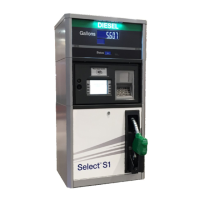W2940305 Rev 07 8/2019 Dover Fueling Solutions 47
6 Maintenance
6.1 Preventive Maintenance
The safety precautions described in Section 2.2 apply to the following preventive
maintenance procedures. A correctly installed dispenser, given proper preventive
maintenance attention, will seldom require emergency service. Perform the following checks
on a regular basis:
Check the dispenser for internal and external leaks regularly. Check nozzles, swivels,
hoses, filters, and joints for leaks and wear. Have all defects repaired immediately.
Do not abuse the hose by trying to stretch it to reach a vehicle. This will cause early
failure at the couplings.
Keep the dispenser clean at all times. See Section 6.3 for cleaning/polishing instructions
and warnings.
Test the tank for water regularly. Water in petroleum is not only a source of engine
trouble, but will also cause damage to the pump.
Periodically check and lubricate all key lock cylinders and locking mechanisms.
6.2 Strainer/Filter – Gasoline & Diesel Dispensers
A dirty strainer screen and/or filter will slow down the product delivery. With new tank and
piping installations, it may be necessary to replace the filter and clean the strainer screen two
or three times during the first few days of operation to remove installation debris and pipe
sealant. After this, filter replacement and strainer cleaning should be performed periodically.
Filters should not be left in place for extended periods of time to avoid corrosion according
the filter manufacturer’s recommendations.
Before removing the filter or strainer, always turn off the power to the dispenser, and if
applicable, turn off the power to the submersible pump and close the emergency shutoff
valve underneath the dispenser. Failure to do so may result in a hazardous condition that
can result in serious injury. Make sure safety goggles are worn. Loosen the strainer cap or
spin-on filter slightly and allow the product to drain into a plastic container until pressure is
relieved. Return the product to the appropriate tank.
The filter is removed by unscrewing it (the same way an oil filter is removed from a car
engine). Place a container under the filter to catch the product and sediment. To install
the new filter: apply a film of oil to the gasket, hand turn until gasket contacts base, then
tighten 3/4 turn (follow any directions supplied with filter). Open the emergency shutoff
valve (if applicable), turn the electrical power ON and check for leaks.
The dispenser is shipped with a 400 series, 10-micron particulate filter on enhanced
capacity models. This filter does not provide water absorption. A 400 series, 30-micron
hydrosorb filter is provided on super-high capacity models. Also, for some fuels such as
biodiesel and Ethanol blends above E10 or B5, special filter elements are required. On E85
dispenser models, use strainer cartridges marked “E85” manufactured by Central Illinois
Mfg (400BHA-01). The installer and user should make sure the filter meets the requirements
of the application, satisfies local/state/federal codes, and replace the filter with an
appropriate filter as necessary. Some applications, such as aircraft refueling, require special
filtration equipment in order to ensure product purity. Replacement filters must be UL-
recognized.
WARNING
WARNING

